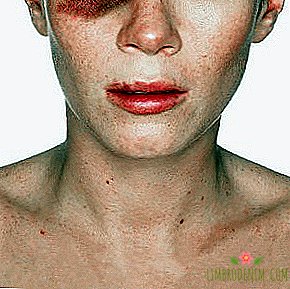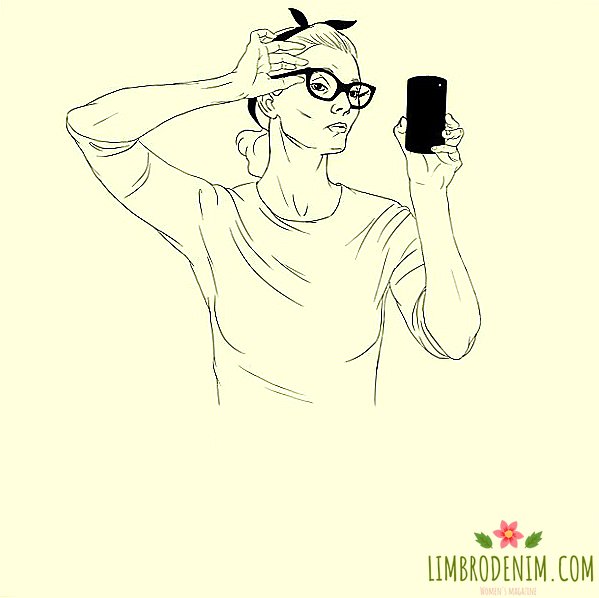"Delete immediately": If you do not have ugly photos - you do not live
Do a simple exercise - how many photos with you are stored on your smartphone? I have 424 (not counting Snapchat), and this number seems huge to me - I am not an Instagram model and still have a little faith that each photo takes a piece of the soul. This wild amount - it doesn't matter if you have 40 or 4 thousand - displays the question "How do I look?" in the league of fundamental questions like "What is the meaning of life?" or "What are we going to watch tonight?"
Ksenia Petrova, Wonderzine news editor
The technological breakthrough, made by mankind in recent decades, is directly related to our obsession with its photogenicity. During the year we produce 50-100 times more photos than were captured on film for all the time it was used, and this number is growing. Soon smartphones with cameras will be in the vast majority of people on earth - more than 5 billion. The photograph also changes as a medium: through Live Photos or Boomerang, it spreads over time, because of Snapchat, it becomes attached to augmented reality, finally blurring the line between what we see on the screen and in the mirror. Like my 4-year-old niece, a great fan of Snapchat, we are looking for dog ears on our head where the app drew them.
According to Nancy Etkoff, author of the book Survival of the Prettiest: The Science of Beauty, people find themselves more attractive than the images in photographs or in the eyes of other people. We live in a world where even the burgers from the nearest fast food in the photos turn out to be a hundred times better than what we have in our hands - and the desire to edit a photo so that it responds to our ideas about its appearance is completely understandable. Moreover, we are no longer limited to 28 frames or a delayed result inherent in analog cameras, and we can always call for help a new view, a new filter or a new contouring technique. Eyes brighter and a smaller nose do not make us a new person, but respond to our ideas about ourselves, which, according to the rules of the vicious circle, we begin to identify with carefully verified selfies. Therefore, the horror of unexpected photos from parties and marks on Instagram acquires a new facet - this is not so much an expose as a ticket to the ominous valley, from where a very similar and very different person looks at us at the same time.
Numerous services of "beautification" work in a similar way - simplified Photoshop versions for smartphones, based on averaged ideas about beauty. One of these tools, developed by a team of Israeli scientists led by Tommer Leyvand, assesses the face according to 84 parameters and slightly changes the features to meet the general ideas about the beauty of the 68 interviewed men and women. The result does not aspire to any common ideal - rather, it implies more symmetry, a narrow face, an open look. (The algorithm did nothing with James Franco.) Such services were especially popular in Korea: face whitening, shine in hair and wrinkle smoothing even became the camera's default setting in Samsung Galaxy smartphones, which caused a social network scandal - and underlined the main problem of such algorithms . They can bring us closer to average attractiveness, but they cannot make us special.
Margarita Virova, beauty editor, Wonderzine
How do computers see us? Can we rely on their eyesight? The digital world penetrates the real, and these questions are no longer idle. First, machines cannot translate the 3D image that you see in the mirror into a 2D image without flattening without flattening your nose or your self-esteem along the way. Secondly, the focal length plays a huge role - the bigger it is, the wider your face seems; best illustrated by hyphae like this. Thirdly, an unsuccessful light can distort your face beyond recognition. Finally, the creators of the technology still cannot rid them of prejudice - and the history of political incorrectness only in photographs is very extensive, starting with Kodak films, sharpened for Europoids, to Google Photos, which confuses African Americans with gorillas.
However, not only technology is to blame for the overestimation of photogenicity. Another reason is money. Our beauty standards are now determined not only by shamelessly retouched photos of Brazilian models and cheap burgers (sorry, I can't get rid of this metaphor), but also by brands that seem to be on the side of an imperfect person. A good example is the American indie brand Glossier, which raised $ 10.4 million in investments to create cosmetics without the effect of cosmetics. For advertising, Glossier take pictures of ordinary girls - often employees of the brand - and, according to brand creator Emily Weiss, use a small amount of retouching compared to other brands.
Instagram brands diligently mimicry your best friend's tape: pizza, pictures on iPhone, nothing too commercial. The strategy justifies itself; 60 thousand people are in line for the brand’s products. But for the subscribers' self-esteem, this affects almost worse than the missing knees or armpits of a heavy-gloss cover model. An entire creative team hardly works on your photos without make-up and with a piece of pizza in your hand, and the result may well fall short of that careless chic that attracts hundreds of thousands of subscribers. Glossier models shine like they never touched a bottle of chardonnay. And I touched, and obviously more often than to stick-highlight.
A critical reader will advise people who have diagnosed themselves incompatible to seal the front camera and permanently remove Instagram. In the long run, however, this decision may have quite a serious and undesirable effect. Mark Simpson, the author of the terms "metrosexuals" and "spornosexuals," put it this way: "In the visual world, you simply do not exist if you are not seen." Due to the peculiarities of behavior in social networks and applications like Tinder, the quality and attractiveness of photography is valued much higher than the rich world of a person on it. Our friends and colleagues are more likely to encounter our doppelganger in social networks and rate us precisely according to him - including attempts to smile at a party likelihood. This even affects job searches - a resume without a photo will attract less attention, as confirmed by our colleagues from The Village. A resume with a bad photo, too.
Olga Strakhovskaya, Wonderzine Chief Editor
What to do with it? The most obvious, but still relevant, way to deal with this is to make non-photogenicity a part of your identity; Let your selfies not sell a single jar of cream, but they are much more humane and can cause a feeling of kinship to a much larger circle of people. The most accurate, perhaps, was formulated by Tusday Bassen, the creator of Zina Ugly Girls Gang: "First of all, it means that you may not care about your appearance, no matter what it is, because it is not an indicator of steepness. secondly, all my work is research and promotion of empowerment with examples of “unpleasant,” “unrecognized,” “not such” women. I love the ugly duality. In the ugly there is power. "
Moreover, what I’ll say now sounds like a hoax, but believe me, it’s very difficult to make a truly ugly photo. 90% of the photos that you are afraid to look at, seem to others to be quite pretty, in the worst case, ordinary. When the Wonderzine editors sent their unfortunate photos for this text (some of them you see in the illustrations), it seemed to me that they misunderstood something - the girls look at them naturally, maybe a little strange, but not at all ugly. Even if you are truly convinced that you are not photogenic, just remove this photo and look at it again after a year - perhaps your attitude towards it will change a lot.
Finally, there is another way out, from its banality that has not become less effective: that which does not turn out to be made beautiful can be made ridiculous. Although too often this practice is used to the detriment — too many people have suffered for the short history of memephication on the Internet — you can curb it and turn it in your favor. In order to make Brigitte Bardot more beautiful, the algorithm of beutification reduced her legendary, significant feature of the face - her lips - having achieved the opposite effect. Even if instead of full lips you have crooked eyes (like mine, for example, with my favorite Swedish band's soloist), in the eyes of the majority this is a moment of uniqueness among the shining un-models that never touched a bottle of wine. And so it will always be while Amy Schumer, throwing Kanye West under her feet, is remembered by us more than the way Kim Kardashian’s contoured cheekbones are immaculate. Let it be so.
Mura, Wonderzine special correspondent
Photo: psiortal.pl via flickr.com




